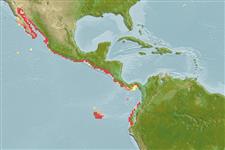Classificação / Names
Common names from other countries
Referência principal
Tamanho / Peso / Idade
Max length : 22.0 cm TL macho/indeterminado; (Ref. 96339); common length : 12.0 cm SL macho/indeterminado; (Ref. 9298); Idade máx. registada: 3 anos (Ref. 905)
Length at first maturity
Lm 12.9, range 12 - ? cm
Ambiente
; marinhas; estuarina; não migratória; intervalo de profundidade 0 - 32 m (Ref. 96339)
Clima / Intervalo
Subtropical, preferred 27°C (Ref. 107945); 32°N - 4°S, 115°W - 78°W (Ref. 54323)
Distribuição
Eastern Pacific: southwestern coast of Baja California, Mexico and from the Gulf of California to northern Peru (up to the Bay of Sechura). Apparently reaching Los Angeles, USA, but these are perhaps releases from tuna boats.
Países | Áreas FAO | Ecossistemas | Ocorrências | Introduções
Descrição breve
Espinhos dorsais (total): 0; Espinhos anais 0; Raios anais moles: 17 - 24. Head large and deep. Snout short and pointed, about 2/3 eye diameter; maxilla moderate, tip blunt, just failing to reach lower jaw articulation; lower gill rakers fine and numerous, increasing in large fishes; no gill rakers on posterior face of third epibranchial. Branchiostegal rays 8, long and slender; branchiostegal membrane broad. Silver stripe disappearing at about 8-10 cm SL.
Categoria na Lista Vermelha da IUCN (Ref. 115185)
Ameaça para o homem
Harmless
Utilização humana
Pescarias: altamente comercial; isco: usually
Mais informação
ReferênciasAquaculturaPerfil para aquaculturaEstirpesGenéticaFrequência dos alelosHereditariedadeDoençasProcessamentoMass conversion
ColaboradoresFotografiasStamps, CoinsSonsCiguateraVelocidadeTipo de nataçãoÁrea branquialOutras referênciasCérebrosVisão
Ferramentas
Relatórios especiais
Descarregue XML
Fontes da internet
Estimates of some properties based on models
Phylogenetic diversity index
PD50 = 0.7500 many relatives (e.g. carps) 0.5 - 2.0 few relatives (e.g. lungfishes)
Nível Trófico
2.5 ±0.21 se; Based on food items.
Resiliência
Elevada, tempo mínimo de duplicação da população menor que 15 meses (K=0.9-2.6; tm=1; tmax=4)
Vulnerabilidade
Low vulnerability (12 of 100)
Categoria de preço
